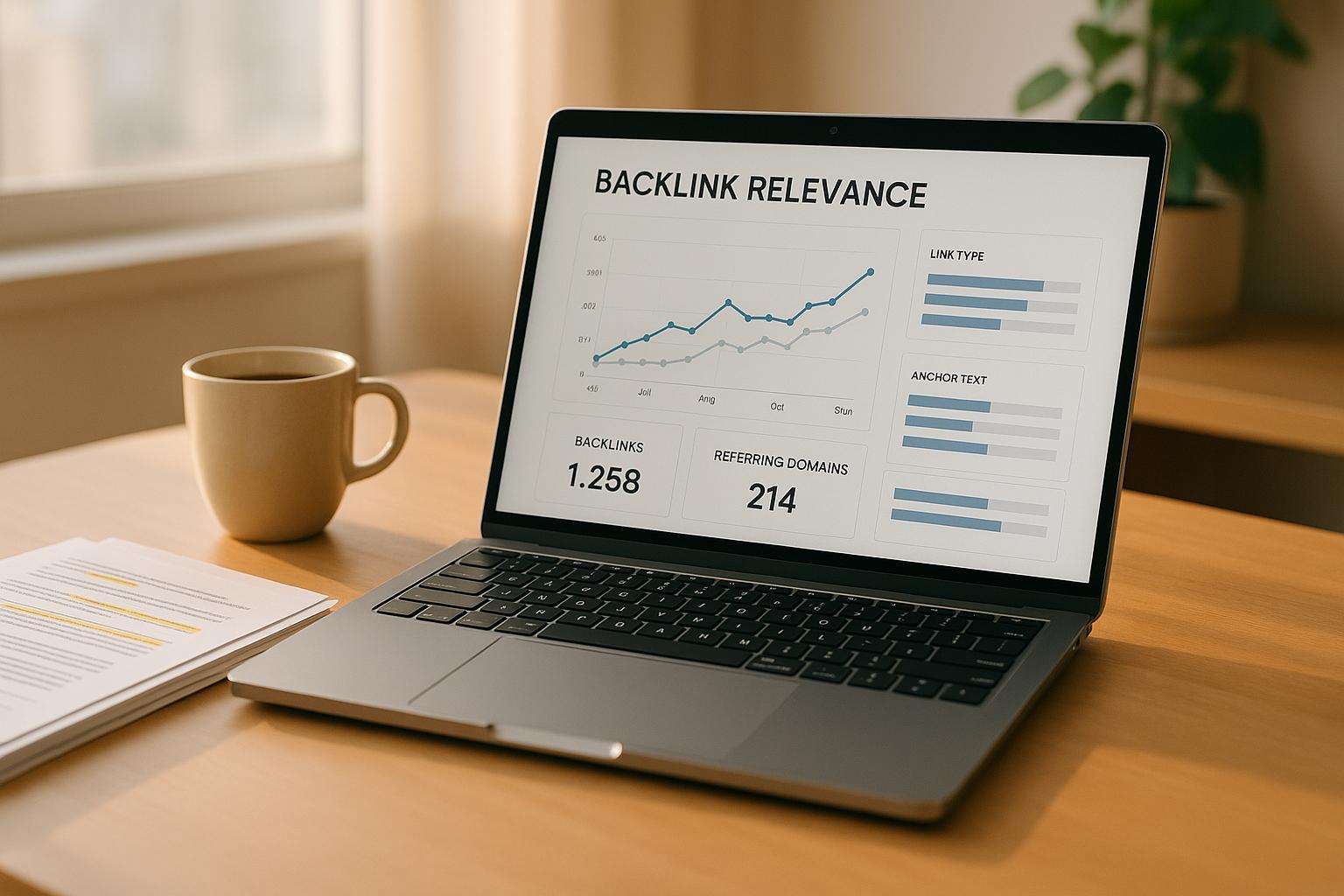Backlink relevance is key to improving SEO. Links from websites closely related to your content are more valuable than random or unrelated ones. Search engines now prioritize the quality and context of backlinks over sheer quantity. Here’s the essence:
- Why it matters: Relevant backlinks boost rankings, attract engaged visitors, and increase conversions.
- What to check: Focus on content alignment, anchor text, and the linking domain’s authority.
- How to analyze: Use tools like Google Search Console, Ahrefs, or SEMrush to gather data on your backlinks.
- What to prioritize: Links from high-quality, topic-specific pages, natural anchor text, and in-content placements.
To improve, audit your backlinks regularly, create content that naturally earns links, and build genuine relationships for outreach. A consistent approach ensures better SEO results over time.
How to Evaluate Backlink Quality | Important Benchmarks You Need To Know
Collecting and Organizing Backlink Data
Before diving into backlink relevance, the first step is gathering detailed data on all the websites linking to yours. This process sets the stage for meaningful analysis and can uncover patterns you might not notice otherwise. Once your data is organized, you’ll have a solid base for evaluating relevance in greater depth.
Tools for Backlink Analysis
When it comes to analyzing backlinks, there are several tools that can help you collect and interpret the data effectively:
- Google Search Console: This free tool from Google is a great starting point. It provides insights into which sites link to yours, though it doesn’t capture every backlink. Head to the "Links" section under "Search Traffic" to see your top linking sites and most linked pages. While the data is limited, it highlights links that Google considers important.
- Ahrefs Site Explorer: Known for its extensive backlink database, this tool offers insights into referring domains, anchor text, and link growth trends. The "Backlinks" report provides detailed information about individual links, including context from the linking page, making it easier to assess relevance. Frequent updates ensure new links are captured quickly.
- SEMrush Backlink Analytics: Another powerful option, SEMrush excels in showing both your backlink profile and those of your competitors. Its "Backlink Gap" feature identifies domains linking to competitors but not to your site, offering potential outreach opportunities.
- Moz Link Explorer: While its database is smaller than Ahrefs, Moz often picks up links that other tools might miss. Its Domain Authority and Page Authority metrics offer quick indicators of link quality, though they should be used alongside other criteria.
Prioritizing Key Data Points
Not all backlink metrics are equally important when evaluating relevance. Focus on the data points that matter most to search engines:
- Referring domain details: Collect information like domain name, page title, and industry focus. This helps identify links that align with your niche and flag those that don’t.
- Anchor text variations: Pay attention to the clickable text of each link. Branded anchors, exact match keywords, and natural descriptions all provide clues about how search engines interpret the link’s relevance.
- Link placement: Where a link appears on a page matters. Links embedded in the main content carry more weight than those in sidebars, footers, or author bios.
- Content themes: Look at the main topic of the linking page and how closely it aligns with your content. For example, a link from a page about "email marketing best practices" to your email automation tool is a strong match.
- Traffic and authority: While not directly tied to relevance, metrics like domain age, organic traffic, and social media presence can help you identify authoritative sources within your niche.
Organizing Backlink Data
To streamline your evaluation, organize your backlink data in a way that highlights relevance patterns:
- Group by relevance categories: Sort links into categories like "Highly Relevant" (industry-specific), "Moderately Relevant" (related topics), and "Low Relevance" (unrelated or questionable sources). This makes it easier to prioritize your analysis.
- Use a structured spreadsheet: Create columns for key details like domain name, linking page URL, anchor text, relevance category, page topic, link placement, and notes. This format allows for easy filtering and sorting.
- Track acquisition timelines: Include discovery dates to spot trends in link-building campaigns or content that attracted the most relevant links. This can guide your future outreach strategies.
- Flag priority links: Identify links that need immediate attention, such as spammy links, irrelevant ones that could harm your authority, or high-value links worth replicating. Flagging ensures these links stand out in your dataset.
- Document referring domains: Keep notes on the primary audience, content style, and linking habits of major referring domains. This context is useful for outreach and evaluating future opportunities from similar sites.
With your data neatly organized, you’re ready to dive into the next phase: analyzing backlink relevance step by step.
How to Evaluate Backlink Relevance Step-by-Step
Evaluating backlinks requires a close look at domain relevance, anchor text, and link placement. Let’s break down each factor to understand how to assess backlinks effectively.
Checking Domain and Content Relevance
To ensure backlinks align with your niche, start by examining the domain and its content. A link only holds value if the source fits your topic and appeals to your audience.
- Domain Focus: Review the linking site’s homepage, main navigation, and recent posts. For example, a fitness equipment retailer linking to a health and wellness blog would make sense. On the other hand, a link from a gambling site would feel out of place.
- Page Relevance: Even if the domain fits, the specific page matters. A marketing software company getting a link from a business publication seems relevant. However, if the link is buried in an article about office furniture instead of marketing strategies, its relevance diminishes.
- Content Quality: Low-value links often come from pages with thin content or excessive ads. High-quality pages with in-depth, meaningful content that naturally reference your site provide stronger connections.
- Geographic Relevance: For local businesses, links from geographically relevant sources carry extra weight. For instance, a Denver-based restaurant benefits more from links on local food blogs or Denver tourism sites than from unrelated locations.
Analyzing Anchor Text
Anchor text gives search engines and users clues about the link’s context. A natural mix of anchor text types is key to building credibility.
- Variety in Anchor Text: Use a mix of your brand name, partial mentions, generic phrases like "click here", and descriptive text. This variety appears more organic than repeating the same keyword-rich anchor text.
- Contextual Integration: The anchor text should flow naturally within the content. For example, a link with the anchor text "email marketing automation tools" embedded in a discussion about improving marketing efficiency feels natural. If it’s awkwardly placed or irrelevant, it raises red flags.
- Avoid Over-Optimization: Patterns of identical keyword-rich anchor text across multiple low-quality sites suggest artificial link building. Search engines may penalize such practices.
- Brand Mentions: Links using your company name or branded terms are less risky and help establish trust. They also tend to attract more qualified traffic since users already recognize your brand.
- Editorial Context: Links embedded in genuine editorial content, surrounded by relevant discussion, carry more weight than those in promotional sections or author bios.
Checking Link Placement
Where a link appears on a page can significantly influence its value and relevance. Placement offers important clues about the link’s importance.
- In-Content Links: Links within the main article text or blog post carry the most weight. These editorial endorsements are viewed favorably by search engines and often drive better traffic.
- Above-the-Fold Positioning: Links visible without scrolling tend to get more attention and clicks. Although below-the-fold links still hold value, they may carry slightly less weight.
- Avoid Low-Value Placements: Links in sidebars, footers, or comment sections often contribute less SEO value. Site-wide footer links, in particular, can appear suspicious if they’re repeated across hundreds of pages.
- Author Bio Links: These links are useful for brand awareness and direct traffic but don’t carry the same SEO weight as in-content links.
- Link Environment: Pages with too many outbound links dilute the value of each one. Conversely, pages with a few carefully chosen links signal higher editorial selectivity.
- Proximity to Relevant Content: Links near related keywords or supporting information reinforce their relevance. Disconnected links can appear unnatural.
- Purpose of the Page: Links from resource pages, curated lists, or editorial roundups often carry strong relevance signals. However, links from pages created solely to host outbound links tend to hold less value.
Key Metrics and Tools for Measuring Backlink Relevance
Once you’ve gathered your data, the next step is refining your evaluation of backlink relevance. This is where key metrics and specialized tools come into play, helping you determine how well your backlinks align with your SEO goals.
Important Backlink Metrics
When assessing backlinks, several metrics stand out as critical indicators of their value:
- Domain Authority and Similar Scores: Tools like Moz’s Domain Authority (DA), Ahrefs’ Domain Rating (DR), and SEMrush’s Authority Score (AS) measure the overall strength of a website based on its backlink profile. Higher scores typically indicate stronger sites. For example, a link from a DR 70 site carries more weight than one from a DR 20 site, but relevance to your content remains a key factor.
- Page Authority and URL Rating: These metrics focus on individual pages. Moz’s Page Authority (PA) and Ahrefs’ URL Rating (UR) evaluate the ranking potential of specific pages linking to your site. Even on high-authority domains, individual pages can vary greatly in strength. A link from a well-established page (e.g., UR 40+) that’s contextually relevant is far more valuable than one from a weak or unrelated page.
- Referring Domains: This metric tracks the diversity of your link sources. A varied profile with links from multiple domains signals authenticity and authority to search engines. Over-relying on a handful of sources can look unnatural, so aim for a broad mix of referring domains.
- Link Relevance: This measures how closely the content of the linking page aligns with your own. Links from pages that discuss similar topics or serve related audiences carry more weight in terms of SEO and traffic quality. Tools analyze content and group topics to score relevance.
- Anchor Text Distribution: A natural link profile includes a mix of anchor text types – branded terms, partial-match keywords, generic phrases like "click here", and exact-match keywords. Over-optimization with too many exact-match anchors can lead to penalties, while a diverse mix signals editorial credibility.
- Dofollow vs. Nofollow Ratio: Dofollow links pass authority and directly impact rankings, while nofollow links (including
rel="ugc"andrel="sponsored") don’t pass ranking value but contribute to a natural-looking profile. A completely dofollow profile can raise red flags, so maintaining a balanced mix is key.
These metrics, combined with the qualitative checks discussed earlier, provide a comprehensive view of your backlink profile.
Recommended Backlink Analysis Tools
No single tool does it all, so most SEO professionals use a combination to get a complete picture. Here’s a breakdown of some of the top backlink analysis tools:
| Tool | Best For | Key Features | Pricing Range |
|---|---|---|---|
| Ahrefs | Comprehensive backlink data | Largest link database, URL Rating, anchor text analysis, link intersect feature | $99-$999/month |
| Moz Pro | Authority metrics | DA/PA scoring, spam score, link research campaigns | $99-$599/month |
| Semrush | Competitive analysis | Authority Score, toxic link detection, backlink gap analysis | $119-$449/month |
| Majestic | Link quality assessment | Trust Flow, Citation Flow, topical trust analysis | $49-$399/month |
- Ahrefs: Known for its extensive link database, Ahrefs excels at uncovering new opportunities. Its URL Rating system offers reliable page-level insights, while features like Site Explorer track referring domain growth and anchor text trends.
- Moz Pro: Moz pioneered the Domain Authority metric and continues to refine its tools with features like spam score detection and link research campaigns.
- Semrush: Perfect for competitive analysis, Semrush highlights sites linking to competitors but not to you. Its Backlink Audit tool also flags potentially harmful links.
- Majestic: Focused on link quality, Majestic uses Trust Flow to measure proximity to trusted sites and Citation Flow to assess link volume, making it ideal for distinguishing high-quality links from lower-value ones.
These tools often integrate with broader SEO platforms, allowing agencies and businesses to combine backlink analysis with other optimization strategies. For example, professional link building services often rely on multiple tools to craft data-driven strategies.
Ultimately, while these tools provide the numbers, it’s human judgment that determines whether a link truly aligns with your brand and SEO objectives. Combine the metrics with a critical eye to build a backlink profile that supports your goals, whether that’s boosting domain strength, driving traffic, or showcasing your expertise in a specific niche.
Building a Relevant Backlink Profile
Creating a strong backlink profile isn’t something you can check off a to-do list and forget. It’s an ongoing process that requires consistent effort and strategic planning.
Key Takeaways
When evaluating backlinks, focus on three essential principles: content alignment, contextual relevance, and quality metrics. Together, these elements ensure your backlinks support your authority and expertise in your niche.
- Content alignment: Links from pages that cover similar or related topics boost relevance. For instance, a link from a niche-specific blog carries more weight than one from a general, unrelated site.
- Contextual relevance: This goes beyond the surface, looking at how naturally the link fits within the content. A link embedded in an article about sustainable farming practices will resonate far more than one forced into an unrelated discussion.
- Quality metrics: Use tools to measure link strength. Look for Domain Authority scores above 30, a balanced mix of anchor texts, and a healthy ratio of dofollow to nofollow links. A profile with many relevant links often outperforms one relying solely on a few high-authority but irrelevant backlinks.
Finally, apply human judgment. Consider factors like the reputation of the linking site, how well their audience aligns with yours, and whether the connection makes sense for your business. Regularly audit your links to refine your strategy and ensure they align with these principles.
Next Steps for Improvement
To enhance your backlink profile, start by auditing your existing links. Export your backlink data and group links into categories: highly relevant, moderately relevant, or irrelevant. This exercise can uncover gaps in your current strategy and highlight areas for growth.
Make it a habit to monitor new backlinks monthly. Most backlink tools offer alerts for newly discovered links. While it’s important to keep an eye on your profile, avoid obsessing over daily changes – backlink growth is a gradual process, and your time is better spent on proactive strategies.
Create content designed to attract links. Research-heavy articles, industry surveys, and in-depth guides naturally draw backlinks from other sites. Plan quarterly pieces that act as "link magnets" for your niche. Over time, these assets will establish your site as a go-to resource.
Build genuine relationships before requesting links. The best backlinks often come from professional connections. Engage with industry blogs, contribute thoughtful comments, and participate in relevant communities. When the time comes to request a link, you’ll be reaching out as a familiar name, not a stranger.
If you need extra support, services like SearchX’s SEO offerings can help fast-track your efforts. They specialize in building link profiles tailored to your industry and audience.
Keep an eye on your referring domains, authority scores, and overall link relevance. Focus on long-term trends rather than short-term fluctuations. Aiming to grow your referring domains by 10-15% each quarter is a realistic and sustainable goal, unlike aggressive pushes that often lead to lower-quality links.
The secret to success lies in consistency and patience. A strong backlink profile doesn’t happen overnight – it’s built through valuable content, genuine relationships, and a commitment to high standards. Over time, these efforts will pay off, boosting your search rankings and driving meaningful traffic from the audience you care about most.
FAQs
How do I find and evaluate the most relevant backlinks for my niche?
To find backlinks that matter, focus on links from websites within your industry or niche. Check how well the content on the linking page aligns with your site, pay attention to the anchor text (the clickable words used for the link), and look at the context where the link is placed.
Give priority to backlinks from trusted, high-quality sources that appeal to your audience. These links should blend naturally into the content and offer real value by guiding users to relevant topics or helpful solutions.
How can I build high-quality backlinks that are relevant to my content?
To secure backlinks that genuinely add value, aim for links from reliable, niche-specific websites with strong authority. The key is creating content that stands out – think detailed guides, unique research, or visually appealing infographics that people want to share. Explore industry-specific opportunities like guest blogging on well-regarded platforms or teaming up with respected partners. Always focus on links that seamlessly fit into the context and enhance the experience for your audience.
How often should I review my backlinks to keep them relevant and effective for SEO?
To keep your backlink profile aligned with your SEO objectives, it’s smart to review it every 6 to 12 months. If your site operates in a competitive industry or undergoes frequent updates, conducting these reviews quarterly could be even more effective.
Regularly auditing your backlinks helps you spot and deal with spammy or low-quality links, which can harm your site’s reputation and search engine rankings. By staying on top of this, you ensure your backlinks continue to be a strong asset in your SEO efforts.




